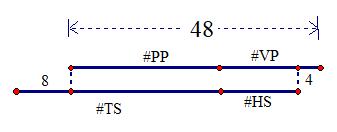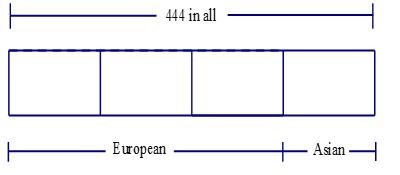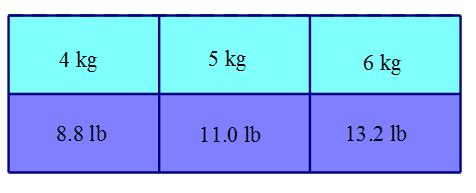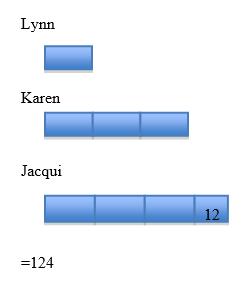1. Give an example of a quantity. What is a possible value for your example?
ANSWER: A possible example is the length of this room. A possible value is 20 feet.
2. Name five quantities that you have dealt with so far today.
ANSWER: Possible answers include: distance from home to class; time spent traveling from home to class; amount of gasoline purchased; amount of milk drunk at breakfast; amount of money spent on a Starbucks coffee; etc.
3. Name three quantities that relate to you, and tell how they are measured.
ANSWER: Possible answers include: weight (in pounds or kilograms); height (in inches); arm span (inches); shoe size (standard sizes for shoes); waist size (in inches); etc.
4. Would student motivation be difficult or easy to quantify? Explain. Tell how you might go about quantifying student motivation in this class.
ANSWER: Probably difficult. Factors influencing motivation might include: need for a passing grade; desire to understand content; parental pressure; peer pressure; etc. A scale (such as 1 low to 10 high) could be designed to measure these factors.
5. How can the term "big" be quantified?
ANSWER: Possible answers include: height; weight; popularity; etc.
6. Give two quantities that one could have in mind when he/she says, "This has been a good day."
ANSWER: Possible answers include: outside temperature; amount of work accomplished; amount of time spent playing ball and/or picnicking; etc.
7. List at least five relevant quantities that are involved with this problem situation. For each quantity, if the value is given, write it next to the quantity. If the value is not given, write the unit you would use to measure it. Pat and Li left the starting line at the same time, running in opposite directions on a 400-meter, oval-shaped race track. Pat was running at a constant rate of 175 meters per minute. They met each other for the first time after they had been running for 1.5 minutes. How far had Pat run when Li completely finished one lap?
ANSWER: Sample answers (quantity, value or unit if value unknown; other units possible e.g., seconds instead of minutes):
Length of track, 400 meters
Pat's speed, 175 meters per minute
Time until they meet for first time, 1.5 minutes
Distance Pat has traveled when they meet for first time, meters
Distance Li has traveled when they meet for the first time, meters
Li's speed, meters per minute
Time for Li to run one lap, minutes
Name: Class: Date:
1
Chapter 01: Reasoning About Quantities Copyright Macmillan Learning. Powered by Cognero. Page
Please contact me at nail.basko@gmail.com for more info about complete file with all chapters.
Chapter 01: Reasoning About Quantities
Time for Pat to run one lap, minutes
Distance Pat has run when Li finished one lap, meters
(The above are relevant to one solution, but the following are quantities in the situation as well.)
Difference in time for one lap for Pat and Li, seconds or minutes
Difference in speeds, Pat and Li, meters per minute
8. Carry out a quantitative analysis of the following problem situation by answering each of the questions that follow.
Jennie got on the freeway at 2:00 PM, using the entrance closest to her home, and traveled at 55 mph to the College Avenue exit, where she turned off at 2:12 PM. Her roommate Cassie had finished her morning classes and was headed home at about the same time. Cassie entered the freeway from the College Avenue entrance at 2:08 PM and traveled to the home exit at 60 mph. At what time did Cassie arrive at the exit ramp to go home?
A) What quantities here are critical?
B) What quantities here are related?
C) For what quantities do I know the value?
D) For what quantities do I need to know the value?
ANSWER: A) Jennie's starting time, Jennie's exit time, time Jennie traveled, speed Jennie traveled, distance Jennie traveled, Cassie's starting time, distance Cassie traveled, speed Cassie traveled, time Cassie traveled
B) All in part A are related, but in different ways.
C) Jennie's starting time, Jennie's exit time, speed Jennie traveled, Cassie's starting time, speed Cassie traveled
D) Time Jennie traveled, distance Jennie traveled (= distance Cassie traveled), time Cassie traveled (to get Cassie's exit ramp time)
9.
Consider this problem situation:
The school cafeteria is ready to serve two kinds of sandwiches, tuna and ham, and two kinds of pizza, pepperoni and vegetarian. There are 48 servings of pizza prepared. There are eight more tuna sandwiches prepared than there are servings of pepperoni pizza. There are four fewer ham sandwiches prepared than there are servings of vegetarian pizza. Altogether, how many sandwiches are prepared?
A) List eight quantities involved in this problem.
B) Sketch a diagram to show the relevant sums and differences in this situation.
C) Solve the problem.
ANSWER: It will be difficult for your students to avoid algebra or trial-and-error on this problem; decide whether you wish to prohibit the use of algebra. You might also consider omitting part C.
A) For example: number of kinds of sandwiches, number of kinds of pizza, number of servings of pizza prepared, difference in number of tuna sandwiches prepared versus number of servings of pepperoni pizza, difference in number of ham sandwiches prepared versus number of servings of vegetarian pizza, total number of sandwiches prepared, number of tuna sandwiches prepared, number of ham sandwiches prepared, number of servings of pepperoni pizza, number of servings of vegetarian pizza, difference in number of tuna sandwiches and number of ham sandwiches
B) There are other praiseworthy drawings possible, but the diagram below suggests the solution (for the total number of sandwiches) pretty easily.
Copyright Macmillan Learning. Powered by Cognero. Page 2
Name: Class: Date:
Chapter 01: Reasoning About Quantities
C) There are 52 sandwiches prepared in all (8 + 48 – 4).
10. Considering the following problem situation:
Two trains leave from different stations and travel toward each other on parallel tracks. They leave at the same time. The stations are 217 miles apart. One train travels at 65 mph, and the other travels at 72 mph. How long after they leave their stations do they meet each other?
List six quantities in the problem (note that you are not asked to solve this problem). If a value is given, write it next to the quantity. If no value is given, write an appropriate unit of measure.
ANSWER: Sample answers (quantity, value or unit if value unknown):
Distance between stations, 217 miles
Speed of one train, 65 miles per hours
Speed of other train, 72 miles per hour
Total speed of the two trains, miles per hour
Time until trains meet, hours (or minutes)
Distance first train has traveled when they meet, miles
Distance second train has traveled when they meet, miles
11. Carry out a quantitative analysis of the following problem situation by answering each of the questions that follow, and then solve the problem:
A butcher had two pieces of bologna, A and B, with A weighing 3 1/3 times as much as B. After the butcher cut 1.8 pounds off A, A was still 2 1/3 times as heavy as B. How many pounds does piece B weigh?
A) What quantities here are critical?
B) What quantities here are related?
C) For what quantities do I know the value?
D) For what quantities do I need to know the value?
E) Use a diagram to find the weight of B, in pounds.

ANSWER: A) Weights of pieces A and B before and after cut, comparison (ratio) of pieces before cut, comparison (ratio) of pieces after cut, weight of piece cut from A
B) Same as in part A, along with weight of B
C) Weight of A, weight cut from A, ratio of A to B before cut, ratio of A to B after cut
D) Weight of B
E) Before cut: 1.8 pounds After cut:
Copyright Macmillan Learning. Powered by Cognero. Page
Name: Class: Date:
3
Chapter 01: Reasoning About Quantities

Piece B must weigh 1.8 pounds.
12. Consider the following problem situation:
Two boats simultaneously left a pier and traveled in opposite directions. One traveled at a speed of 18 nautical miles per hour and the other at 22 nautical miles per hour. How far apart were they after 2.5 hours?
List five relevant quantities that are involved in this problem. For each quantity, if a value is given, write it next to the quantity. If value is not given, write the unit you would use to measure it and its value if possible.
ANSWER: Speed of first boat, 18 nautical miles per hour
Speed of second boat, 22 nautical miles per hour
Distance traveled by first boat in 2.5 hours, nautical miles: 2.5 × 18 = 45 n.m.
Distance traveled by second boat in 2.5 hours, nautical miles: 2.5 × 22 = 55 n.m.
Total distance between boats at 2.5 hours, nautical miles: 45 n.m. + 55 n.m. = 100 n.m.
13. My brother and I go to the same school. My brother takes 50 minutes to walk to school, and I take 40 minutes. If he gets a 49-minute head start one day, can I catch him before he gets to school? Explain without referring to any short-cut in your explanation. (Hint: Do not do a lot of calculation.)
ANSWER: No. Brother needs only one more minute to get to school, and in one minute, I can travel only 1/40 of the distance to school.
14. My sister can walk from school to home in 40 minutes. I can walk from school to home in 30 minutes. But today I stayed for some extra help, and my sister was already 2/5 of the way home when I started.
If I walk at my usual speed, can I catch my sister before she gets home?
If YES, exactly what fraction of the trip have we covered when I catch her?
If NO, exactly what fraction of the trip have I covered when my sister gets home?
In either case, write enough (words, numbers, drawings) to make your thinking clear.
ANSWER: (Yes/No) Explanation, including fraction of the trip:
Copyright Macmillan Learning. Powered by Cognero. Page 4
Name: Class: Date:
Chapter 01: Reasoning About Quantities
No, I cannot catch up with my sister. My sister has 3/5 of the way to go, which should take 3/5 of 40 minutes, or 24 minutes before arriving at home. But in 24 minutes, I can cover only 24/30, or 4/5, of the way home. On the diagram, my sister is at the second dot (16 minutes) when I begin and has 24 minutes of walking before arrival. In those 24 minutes, I can walk only to X.
15. The big dog weighs five times as much as the little dog. The little dog weighs 2/3 as much as the mediumsized dog. The medium-sized dog weighs 9 pounds more than the little dog. How much does the big dog weigh?
A) List three quantities associated with this problem. If possible, give the associated value.
B) Draw a diagram to represent the quantities in this problem.

C) This diagram was provided by a fifth-grader. Tell why it is not helpful.
D) Solve the problem and explain your solution process.
ANSWER:
A) For example: weight of large dog, weight of medium dog, weight of small dog, large dog's weight in terms of small dog's weight, small dog's weight in terms of medium dog's weight

C) The diagram does not tell anything about their sizes other than which was larger and smaller than the medium dog.
D) From the diagram for part B, if the medium dog is 9 pounds more than the small dog, then the medium dog weighs 27 pounds and the small dog weighs 18 pounds. The large dog weighs five times as much as the small dog, so it is 5 × 18 = 90 pounds.

16. The label on a can of chicken broth claims that its weight is 1.4 kg. Use your metric knowledge to tell how many milligrams this would be
ANSWER: 1,400,000 mg
Copyright Macmillan Learning. Powered by Cognero. Page 5
Name: Class: Date:
B)
Chapter 01: Reasoning About Quantities
17. The larger the unit of measure used to express the value of a specific quantity, the larger its numeric value will be.
a. True
b. False
ANSWER: b
18. Give an estimate of the following and explain how you did it. The length of this line in metric units:
ANSWER: (Note to instructor: Measure this line as it is printed out before using it in a test.)
19. List the following measurements in order from greatest to least: 8 m, 359 cm, 66 m, 3912 mm, 5198 cm, 7 m
ANSWER: 66 m, 5198 cm, 8 m, 7 m, 3912 mm, 359 cm
20. How many grams are there in centigrams?
a. 1 × 10 –2
b. 100
c. 0.001
d. 1 × 102
ANSWER: a
21. If a Pascal is some unit of measure, use your knowledge of metric prefixes to complete the following: 4 kiloPascals = Pascals
ANSWER: 4000
22. Name a metric unit that is analogous to a quart. Which is LARGER?
ANSWER: A liter is slightly larger than a quart.
23. Name a metric unit that is analogous to a yard. Which is LARGER?
ANSWER: A meter is slightly larger than a yard.
24. Size 1 Pampers fit babies who weigh 4 to 6 kg. Maggie weighs 11 pounds. Will size 1 Pampers fit her? Justify your answer and use a sketch or diagram to show the relationship between kilograms and pounds. (A kilogram is about 2.2 pounds.)
ANSWER: Maggie weighs 5 kilograms and size 1 Pampers will fit her. (Alternatively, use the 2.2 pounds for 1 kilogram to change the 4 kg–6 kg range to 8.8 pounds–13.2 pounds.)
Copyright Macmillan Learning. Powered by Cognero. Page 6
Date:
Name: Class:
Chapter 01: Reasoning About Quantities
25. What are some advantages to using the metric system of measurement?
ANSWER: The metric system allows easy conversion of units because units differ by powers of ten. It is used in science for this reason, in all countries. Most countries use it for all measures.


26. Some children, when asked to solve a story problem, try different operations on the numbers and then decide which one seems to give the best answer. What is the danger of solving problems in this way?
ANSWER: Students will not know what the answer means. They do not understand the problem, thus they try to find an acceptable answer for the teacher, even though they cannot explain it. Also, being able to find an answer does not necessarily mean that students understand the problem or know what the problem is asking, which may have a negative impact on their understanding long term.
27. Many teachers teach "key words" for solving word problems. What are the limitations of this strategy?
ANSWER: Key words can be misleading they only work part of the time. Students will not know what the answer means. Students may look for key words without trying to understand the problem or what it is asking, which may have a negative impact on their understanding long term.
28. Use a diagram to solve the following problem:
Jesse collects stamps. He now has 444 stamps. He has three times as many stamps from European countries as he does from Asian countries. How many of his stamps are from European countries?
ANSWER:
Since there are 444 stamps in all, 111 are from Asian countries and 333 are from European countries.
29. Use a diagram to solve the following problem:
Copyright Macmillan Learning. Powered by Cognero. Page
Name: Class: Date:
7
Chapter 01: Reasoning About Quantities
Silvia and Jesus are buying a new table and new chairs for their dining area. Chairs with armrests are $45; those with no armrests are $8.50 cheaper. The table is four times as much as a chair without armrests. If they buy a table and six chairs, two with armrests and four without, what is the total price they pay?
ANSWER:
30. Use a diagram to solve the following problem:
Dylan lives 8 miles from campus. Connor lives 2 miles farther away from campus than Dylan does. If each drives a car to campus, how many miles altogether do Dylan and Connor drive to and from campus?
ANSWER:
Dylan drives 10 miles one way, so 20 miles both ways, and Connor drives 16 miles both ways, so together they drive 36 miles per day.

31. Use a diagram to solve the following problem:
A combinded third- and fourth-grade elementary school classroom has 29 students. There are seven more thirdgraders than there are fourth-graders. How many students are there in each grade?
ANSWER: 18 in third grade, 11 in fourth grade
32. Draw a diagram to represent the quantities in the following problem. Solve the problem and explain your solution process.


Jacqui, Karen, and Lynn all own several bottles of nail polish. When they line them up, Jacqui has 12 more bottles than Karen and Karen has three times as many as Lynn. Together, they have 124 bottles of nail polish. How many bottles does each person have?
Copyright Macmillan Learning. Powered by Cognero. Page 8
Date:
Name: Class:
Chapter 01: Reasoning About Quantities

ANSWER: I know they have 124 altogether. I know Karen has three times as many as Lynn. I drew a segment to illustrate the number of bottles that Lynn has. To illustrate the number of bottles that Karen has, I drew Lynn's segment and added two more segments of the same size. Jacqui has what Karen has plus 12 more.
When I add each of their portions together (Lynn's share, Karen's share, and Jacqui's share), they total 124 bottles. In other words, if you picture these bars in a line, you'd see 7 pieces the size of Lynn's share and 12 more to total 124. Therefore, 7 pieces the size of Lynn's share represent 112 bottles (124 – 12). Each piece then represents 112 ÷ 7 or 16 bottles. Lynn's portion is 16 bottles. Karen's is three times as much, or 16 * 3 = 48. Jacqui's is Karen's portion plus 12, or 60.
33. Your elementary student brings in a picture and story about a fat cat brought to an animal shelter weighing a hefty 18.1 kilograms. You want to help them understand how heavy that cat is.
A) How much did the cat weigh in pounds and ounces?
B) What personal benchmark might be useful in understanding this weight?
ANSWER: A) 18.1 kg is 39.82 lbs, or 39 lbs, and roughly 14.5 ounces.
B) Possibilities for benchmarks: 5 gallons of water, a three- to four-year-old little sister or brother
34. Haley and Tyler are solving the following story problem: "One kind of candy costs $3.50 per pound. How much will 0.42 pound cost?"
Haley thinks you should subtract, and Tyler thinks you should divide.
A) What are these children likely to be thinking?
B) Is either correct? Explain your reasoning.
ANSWER: A) They likely realize that 0.42 pound is less than one pound, so they should use an operation that gives a cost less than $3.50.
B) Neither is correct. The operation needed is multiplication. $3.50 × 0.42 lbs. = $1.47.
Copyright Macmillan Learning. Powered by Cognero. Page 9
Name: Class: Date:











